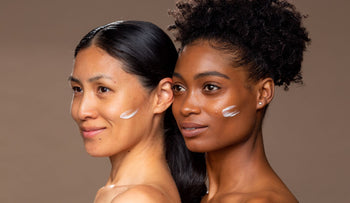SPF stands for Sun Protection Factor, and an SPF should be a part of everyone’s skincare regimen year-round-- regardless of your age, gender or race. SPF isn’t just found in sunscreens you wear to the beach or during recreation, but is found in many skincare and makeup products as well.
As the first skincare company to bring broad-spectrum UV protection to the market, we’ve always been ahead of the game when it comes to SPF. Let’s take a look at how SPF works, what it protects you from and how best to protect your skin from the sun with SPF.
How SPF works
SPF is essentially a rating which tells you how long you can be out in the sun without burning. Products containing SPF work by either absorbing or reflecting UV rays before they can damage your skin. Regardless of the SPF number rating, you will have to apply the product more than once throughout the day. According to the FDA , you should be reapplying sunscreen “at least every two hours, and more often if you're swimming or sweating."
Difference between UVA and UVB rays
Whether you’re trying to prevent skin cancer or are noticing more prominent signs of aging, it’s important to keep your skin protected from the sun’s UV rays all year round. Below, we will look at the different ways that UVA and UVB rays can affect your skin.
UVA rays:
Otherwise known as ultraviolet A rays, UVA rays are most associated with skin damage and premature aging. They have higher wavelengths than other UV rays meaning they can affect cells deeper in the skin, causing damage to cells.
UVA rays can cause premature aging to your skin, such as wrinkles and age spots. So if you want to maintain a more youthful appearance, it’s always best to limit your time in the sun and make sure you’re protecting your skin by liberally applying sunscreen prior to sun exposure.
UVB rays:
Ultraviolet B rays are the burning rays and are thought to cause most skin cancers, as well as premature aging of our skin. These rays have higher energy levels that can cause damage to the outermost layers of the skin, directly damaging our DNA.
Overexposure to UVB rays leads to sunburn, though the effects sometimes aren’t noticeable until a few hours afterward.
Direct exposure to both UVA and UVB rays will cause damage to your skin, speeding up the aging process and increasing your risk for all types of skin cancer. Even if you’re tanning and not burning, it’s worth remembering that there’s no safe way to tan, and you should liberally apply an SPF product each morning and keep your skin covered where possible when out in the sun.
Which rays will SPF products protect me from?
If you want to protect your skin from aging caused by sun damage, opt for a ‘broad-spectrum’ product, which will protect you from both UVA and UVB rays.
Our multi-tasking MULTI CORREXION® 5 In 1 Daily Moisturizer With Sunscreen Broad Spectrum SPF 30 offers protection from both UVA and UVB rays, while visibly lifting and plumping the skin while helping to reduce the occurrence of hard to treat sun spots.

How to protect your skin from the sun
From premature aging to skin damage, and even skin cancer, the sun’s UV rays can cause more damage than we think. Here are some ways you can protect yourself from the sun:
Apply a broad-spectrum SPF product every day, even if it’s cloudy
It’s good practice to apply an SPF product every day to areas of your body that might be exposed to the sun. Some people choose to apply a sunscreen product every day, while others opt for a moisturizer containing SPF, which has additional benefits for the skin. Make sure to re-apply throughout the day and strive for a sunscreen with a minimum of SPF 30, which will block out 97% of UV rays.
Limit your time in the sun
The sun’s rays are strongest between 10:00 AM and 4:00 PM, so if you can, it’s best to avoid being outside for long during these hours. As a general rule, if your shadow is shorter than you are, then the sun is at its most powerful – and you should try and find some shade.
Cover up where possible
While it’s not possible to cover every area of your face, you can better protect yourself by accessorizing with a pair of sunglasses and a hat that shades your face, neck, and ears. You can also find clothes made with special sun-protective materials for skin that’s covered up.
So keep in mind, SPF products will help protect your skin from the sun’s harsh, aging rays; a broad-spectrum product will protect you from both UVA and UVB rays; and moisturizers with SPF will protect the skin while offering other skincare benefits. We recommend our MULTI CORREXION® 5-In-1 Even Tone + Lift Chest, Neck & Face Cream With SPF 30, which fights signs of aging and delivers visibly smoother and healthier looking skin after just 4 weeks of use.
Discover more skincare tips and advice on the RoC Lab Notes blog, or take a look at this useful guide to your summer skincare routine.







